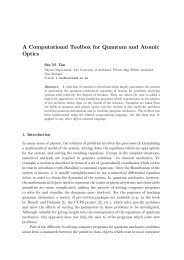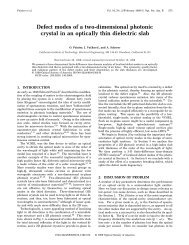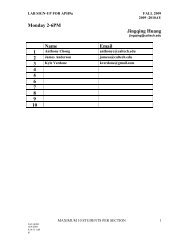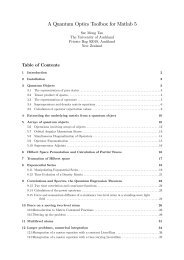Slowing and stopping light using an optomechanical crystal array
Slowing and stopping light using an optomechanical crystal array
Slowing and stopping light using an optomechanical crystal array
Create successful ePaper yourself
Turn your PDF publications into a flip-book with our unique Google optimized e-Paper software.
14<br />
∫<br />
the wavevector <strong>an</strong>nihilation operators by â R (z) = √ 1 ∞ dk 2π −∞ eikz â R,k (with a similar definition<br />
for â L (z)). Equation (A.1) resembles a st<strong><strong>an</strong>d</strong>ard Hamiltoni<strong>an</strong> used to formulate qu<strong>an</strong>tum cavity<br />
input–output relations [36], properly generalized to the case when the cavity accepts <strong>an</strong> input<br />
from either direction. Note that we make the approximation that the left- <strong><strong>an</strong>d</strong> right-going<br />
waves c<strong>an</strong> be treated as separate qu<strong>an</strong>tum fields, with modes in each direction running from<br />
−∞ < k < ∞. This allows both the left- <strong><strong>an</strong>d</strong> right-going fields to separately satisfy c<strong>an</strong>onical<br />
field commutation relations, [â R (z), â R (z ′ )] = [â L (z), â L (z ′ )] = δ(z − z ′ ), while commuting<br />
with each other. Thus each field contains some unphysical modes (e.g. wavevector components<br />
k < 0 for the right-going field), but the approximation remains valid as long as there is no<br />
process in the system evolution that allows for the population of such modes.<br />
From the Hamiltoni<strong>an</strong> above, one finds the following Heisenberg equation of motion for<br />
the right-going field,<br />
( 1 ∂<br />
c ∂t + ∂ ) √<br />
2πig<br />
â R (z) = δ(z − z j )â 1 + ik 0 â R ,<br />
(A.2)<br />
∂z<br />
c<br />
where k 0 = ω 1 /c. A similar equation holds for â L . The coupling of the cavity mode to a<br />
continuum of waveguide modes leads to irreversible decay of the cavity at a rate κ ex . Below,<br />
we will show that κ ex is related to the parameters in the Hamiltoni<strong>an</strong> by κ ex = 4πg 2 /c. With this<br />
identification, one recovers equation (5) in the main text.<br />
The Heisenberg equation of motion for the cavity mode is given by<br />
d<br />
dt â1 = ig √ 2π(â R (z j ) + â L (z j )).<br />
(A.3)<br />
To cast this equation into a more useful form, we first integrate the field equation (A.2) across<br />
the discontinuity at z j ,<br />
√<br />
2πig<br />
â R (z + j ) = â R(z − j ) + â 1 ,<br />
c<br />
√<br />
2πig<br />
â L (z − j ) = â L(z + j ) + â 1 .<br />
c<br />
(A.4)<br />
(A.5)<br />
We c<strong>an</strong> define â L,in (z j ) = â L (z + j ) <strong><strong>an</strong>d</strong> â R,in(z j ) = â R (z − j ) as the input fields to the cavity. It then<br />
follows that<br />
d<br />
dt â1 = ig √ 2π ( ) 2πg 2<br />
â R,in + â L,in − â 1 ,<br />
(A.6)<br />
c<br />
<strong><strong>an</strong>d</strong> thus we indeed see that the waveguide induces a cavity decay rate κ ex /2 = 2πg 2 /c. In<br />
the case where the cavity has <strong>an</strong> additional intrinsic decay rate κ in , a similar derivation holds<br />
to connect the intrinsic decay with some corresponding noise input field â in . From these<br />
considerations, <strong><strong>an</strong>d</strong> including the optomech<strong>an</strong>ical coupling, one arrives at equation (3) in the<br />
main text,<br />
dâ 1<br />
= − κ √<br />
dt 2 â + i ˆb<br />
cκex<br />
m + i<br />
(âR,in (z j ) + â L,in (z j ) ) + √ cκ in â N (z j ). (A.7)<br />
2<br />
Finally, we consider the equation of motion for the mech<strong>an</strong>ical mode given by equation (4)<br />
in the main text,<br />
dˆb<br />
dt = −γ m<br />
2 ˆb + i m â 1 + ˆF N (t). (A.8)<br />
New Journal of Physics 13 (2011) 023003 (http://www.njp.org/)






